After a first interview for LEGION, Jeff Campbell is back on The Art of VFX with a new movie for Spin VFX. In the following interview, he talks about his work on BATTLE LOS ANGELES.
How was the collaboration with director Jonathan Liebesman and production VFX supervisor Everett Burrell?
I’ve worked with Everett on a couple on projects now and it has always been a pleasure. If we need anything he is always willing to help out. Jonathan’s VFX experience is a benefit in our working relationship, especially on a VFX heavy film. He works in After Effects, blocking out shots to give us some idea as to what he is looking for. He has a good eye for details so everything we did had to be absolutely realistic.
How did Spin VFX get involved in this project?
We actually got involved a year prior to production. Spin VFX was asked to help develop the creatures and to finish a few shots in a short film, which was intended to sell the style and dynamics of the project to the studio. I was asked on set along with Everett Burrell, Production VFX Supervisor, to supervise the test. I had the task of supervising a small SFX crew with a Red cam to shoot the VFX elements. The shoot was at the Sony lot, which already looked like it had been bombed out due to construction. Aaron Eckhart, the star of the film, acted in the test to demonstrate his dedication.
After the show was green lit we were invited to bid on a pretty big chunk of the movie which ended up being 200 shots. That made for a really busy summer as we had 3 studio features going on at the same time. Fun.
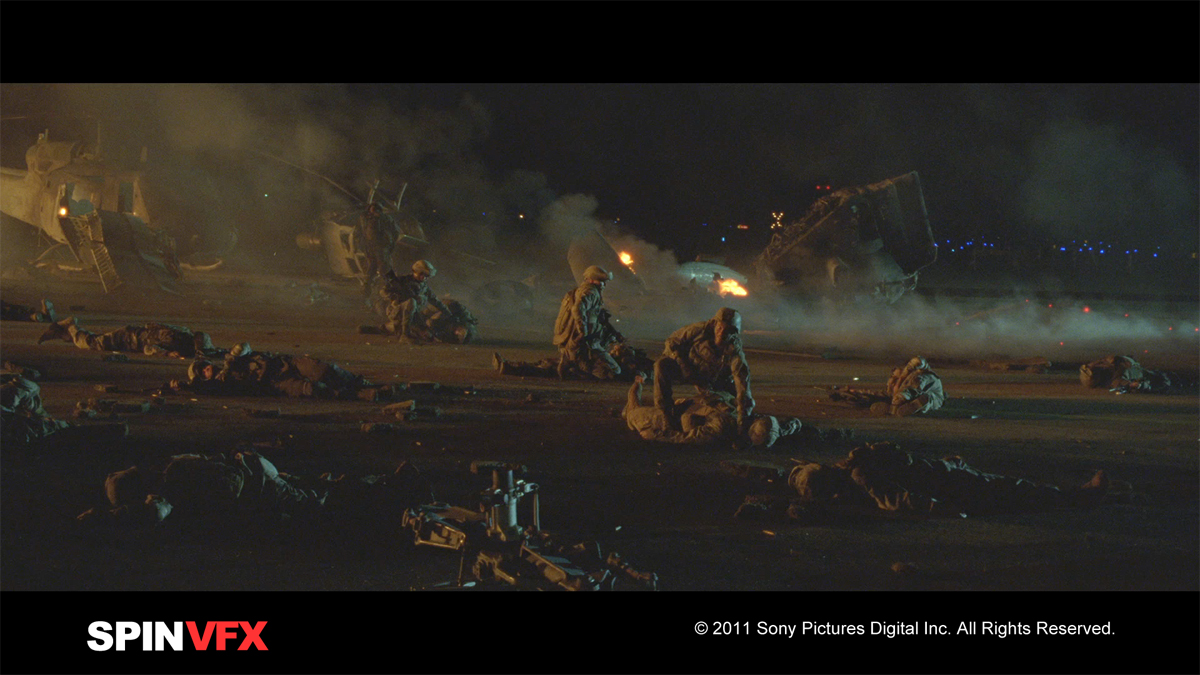 |
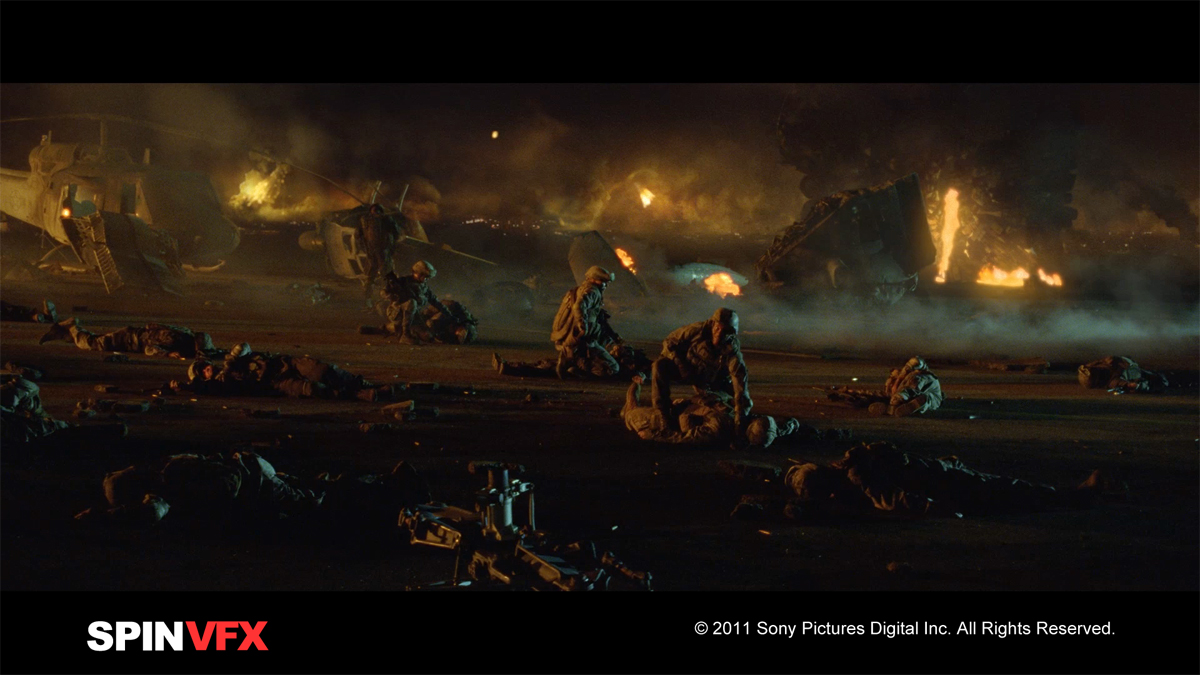 |
What are the sequences made at Spin?
Spin delivered 30 sequences with a variety of different challenges including, environments, creatures, alien ships, Huey helicopters, F18 jet fighters, a Coast Guard Cutter, and Massive crowd shots. Our biggest sequence was the Police Rooftop sequence, with 35 shots.
How was the development of the creatures?
We would receive detailed concept art from Paul Gerrard and then build from there. The textures and displacements were derived from the high res artwork. Maquettes were built for the various creature options and we were also provided turntable stills to reference. I think we built 3 different creatures; mainly the legs would be the most drastic difference. One version had five legs. We would animate the creatures doing various key frame motion tests and walk cycles. I like to assign tests to as many different animators as possible to see what kind of personality shines through in the creature. To get a better feel of scale and the emotion of combat, some of our tests were done using full CG environments of a city street with over turned cars and debris.
Early creature references were very “creature like” but eventually Jonathan referred to real army soldier’s performances. At that point we used motion capture data to drive their performances. In the end, Jonathan decided to go all motion capture for the animation.
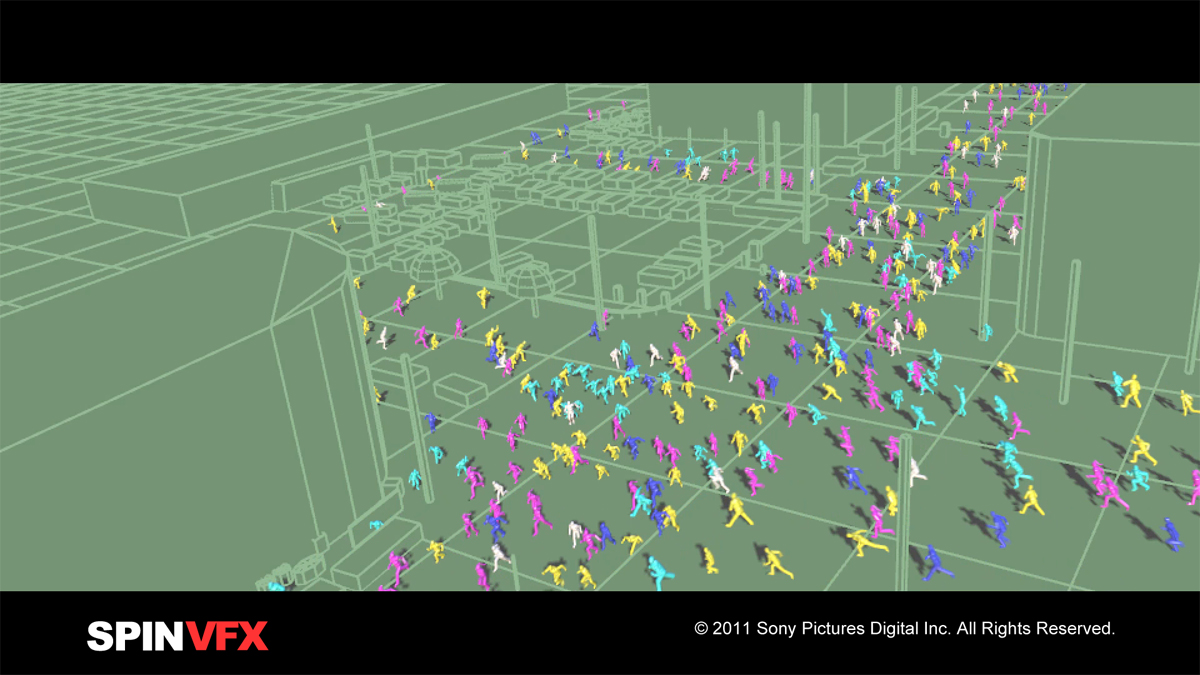 |
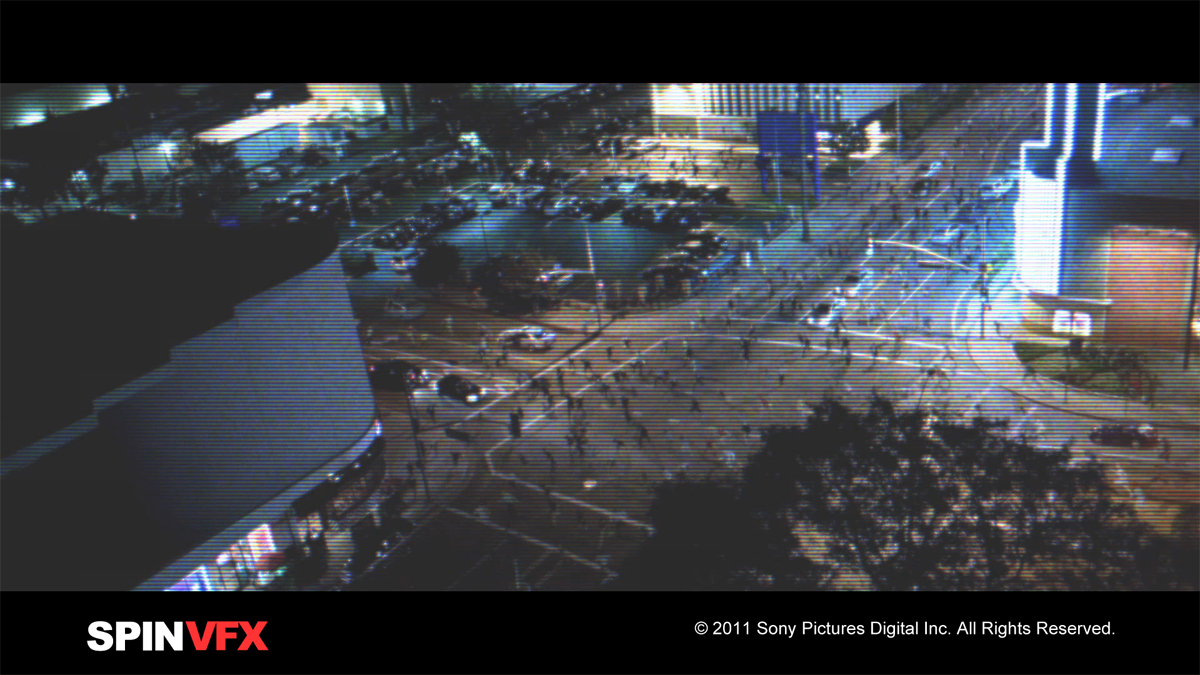 |
How did you create the images that look like TV coverage?
I initially used a plugin called BadTV by GenArts on the Inferno. Once we got a creative signoff as to the look, we made a gizmo in Nuke to replicate this look so all our artist can apply it to their shots.
The TV distortion provided only subtle glimpses of the Aliens to create interest in the viewer to want to see more. The point was that the alien radioactivity interfered with the airwaves.
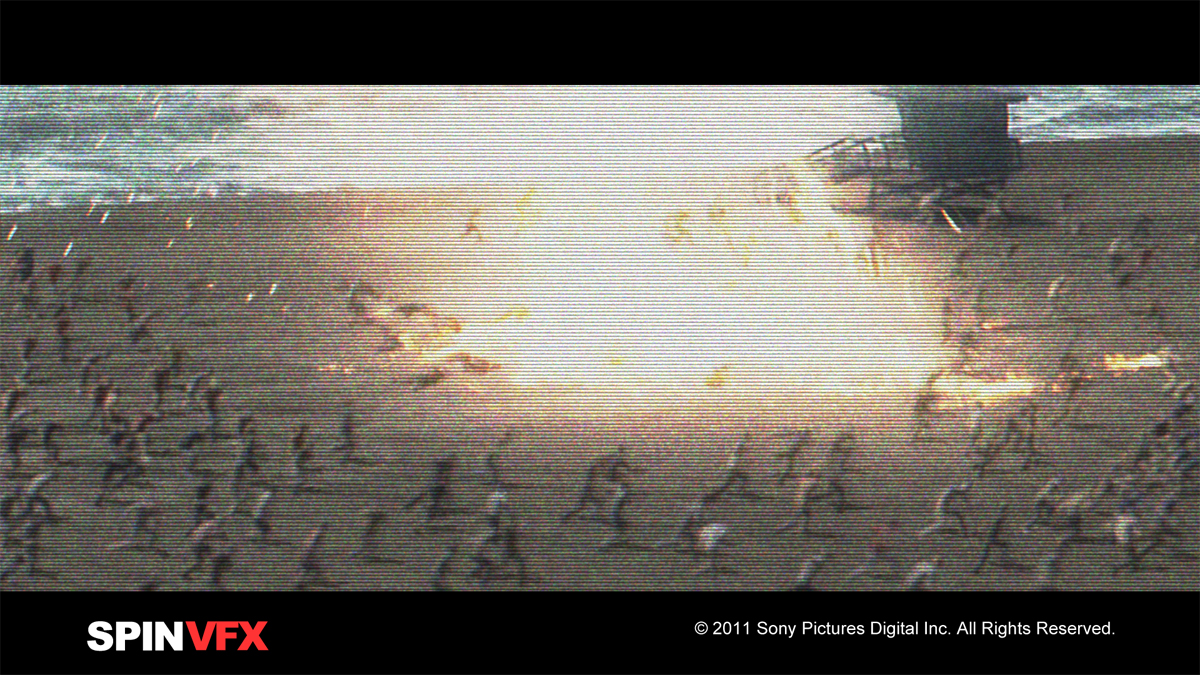 |
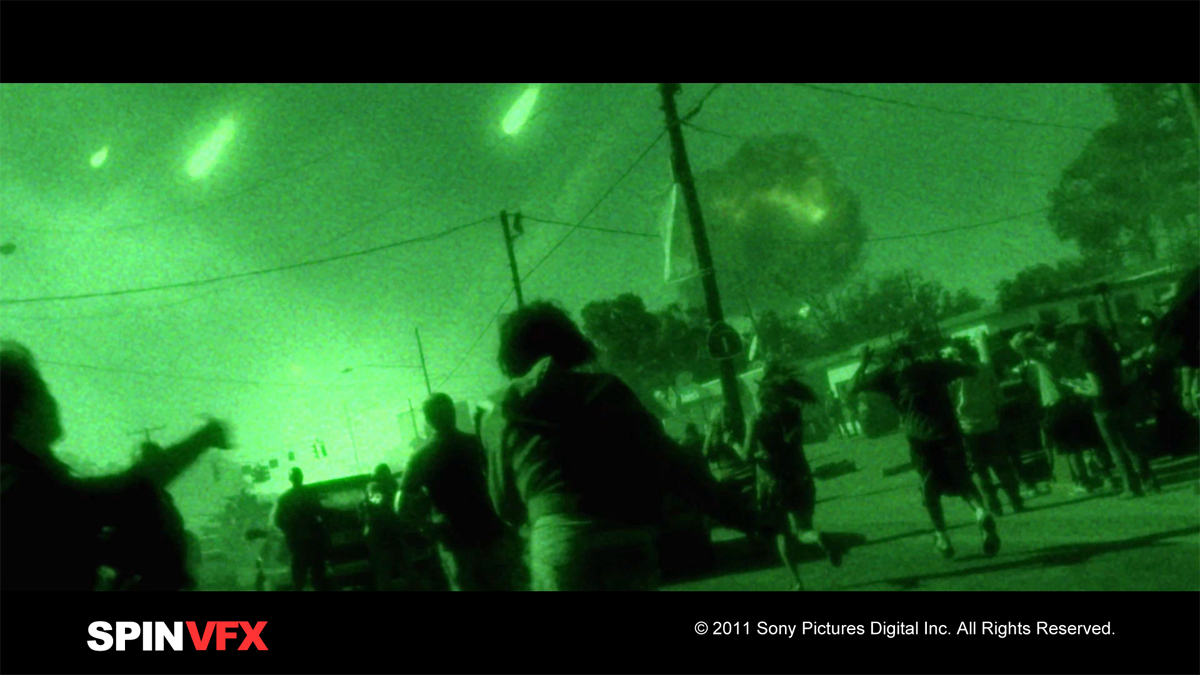 |
Can you explain the attack on the coastguard boat?
We were given WWII footage to match to for the sinking ship shot. The vintage footage was very soft and degraded which was kind of the look requested but we built the ship at a higher level of detail to hold up to any possible client requests. We even animated sailors on board being thrown into sea and hanging on to railings. Our first water sims for the meteor impact were too much as they covered too much of the ship in a huge title wave. We ended up pulling back on the water sim to look more like a heaving of the area from the water displacement of the meteor impact. We then added smaller fluid sims to wash over the deck and for the hull interaction. The elements were then composited in Nuke.
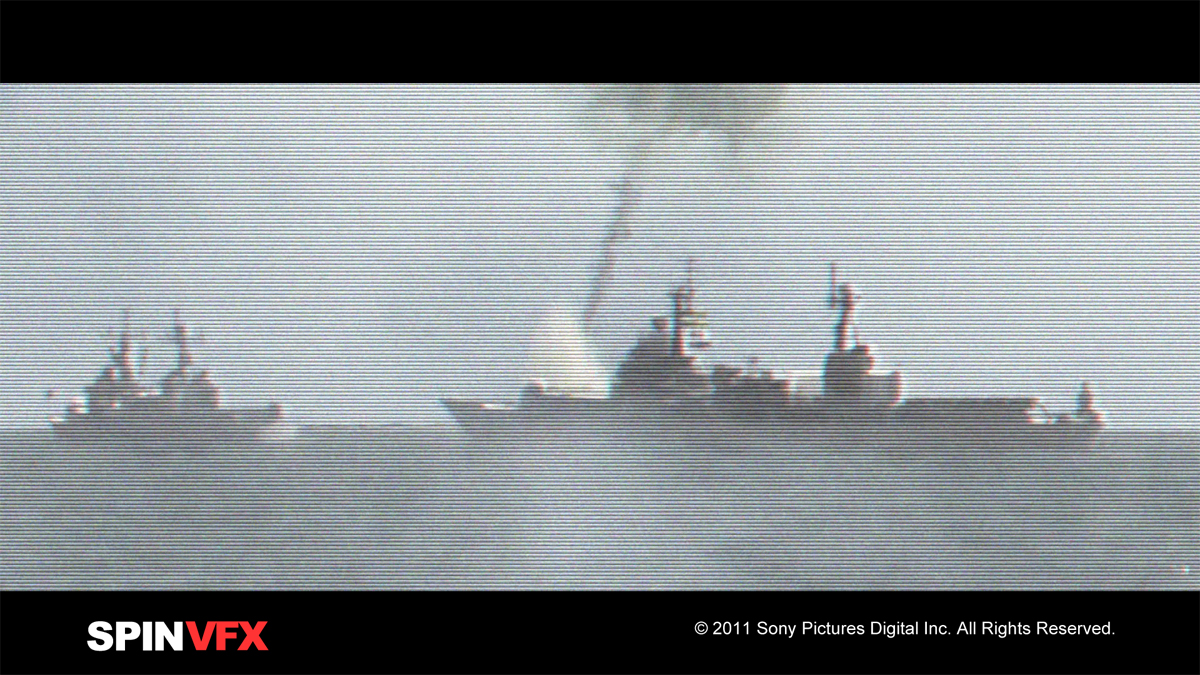 |
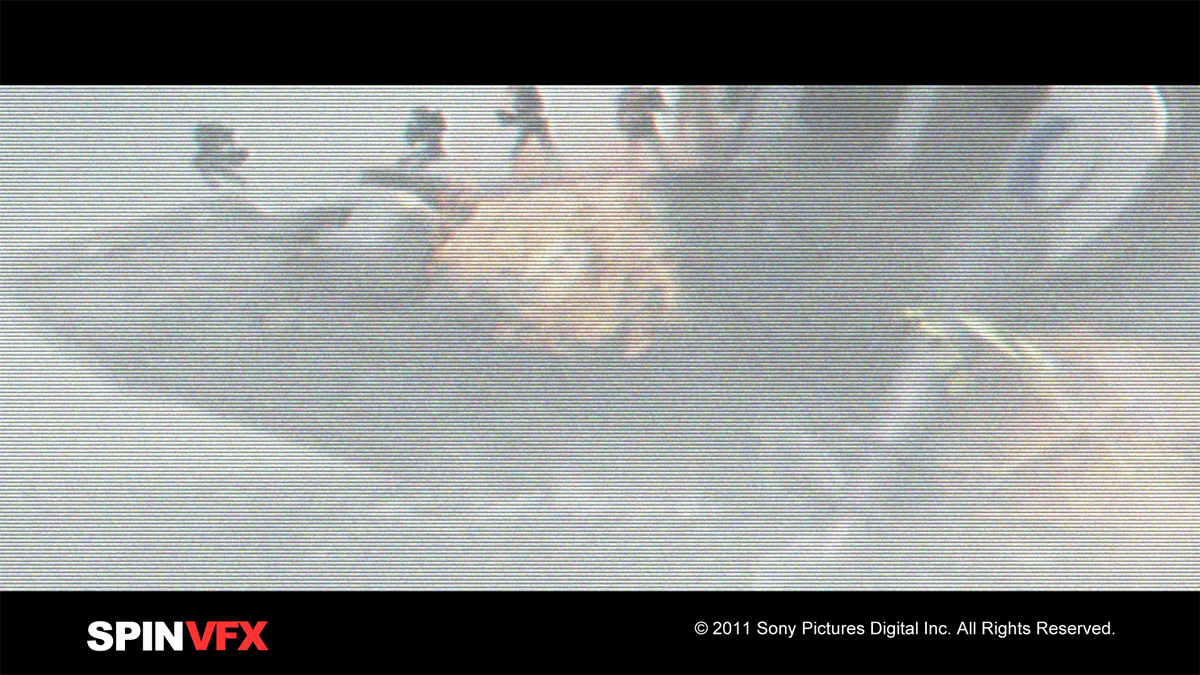 |
How did you create the snipers POV shots?
The story point here was the idea that the aliens had leadership in th form of an alien General. The General did not perform like the others. He would hover over the ground, move like a jellyfish with tentacle legs and do a lot of pointing as he gave orders. So there was some new ground in animation to be addressed. The aliens were motion captured and the General was key-framed because of his unique movement. We had a lot going on in those shots, like many of our shots. We had aliens, a general, a drone ship and lowering cargo, cg dust being kicked up from the roof top, smoke, fires, tracer fire from Soldiers and Aliens and Drone ships / F18 dogfights.
The background was a matte painting of the damaged buildings in which I added live action trees and a beach. I finished the shots in Inferno and added the scope gizmo, which was supplied by The Garage Band, in Nuke.
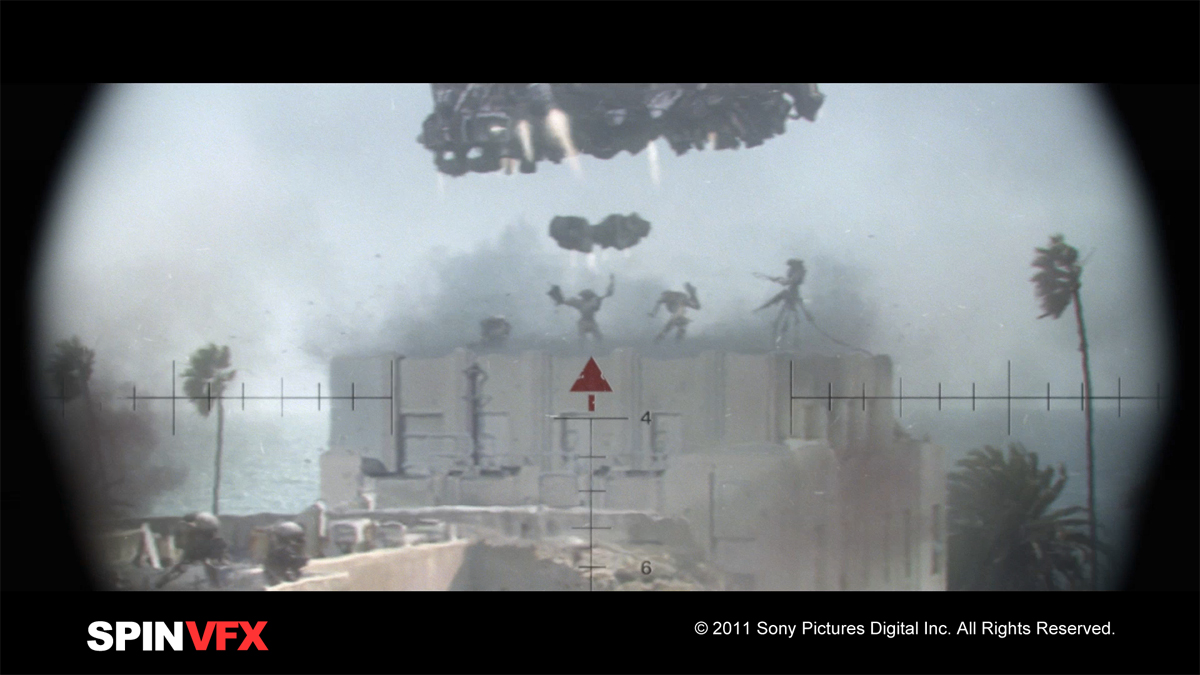 |
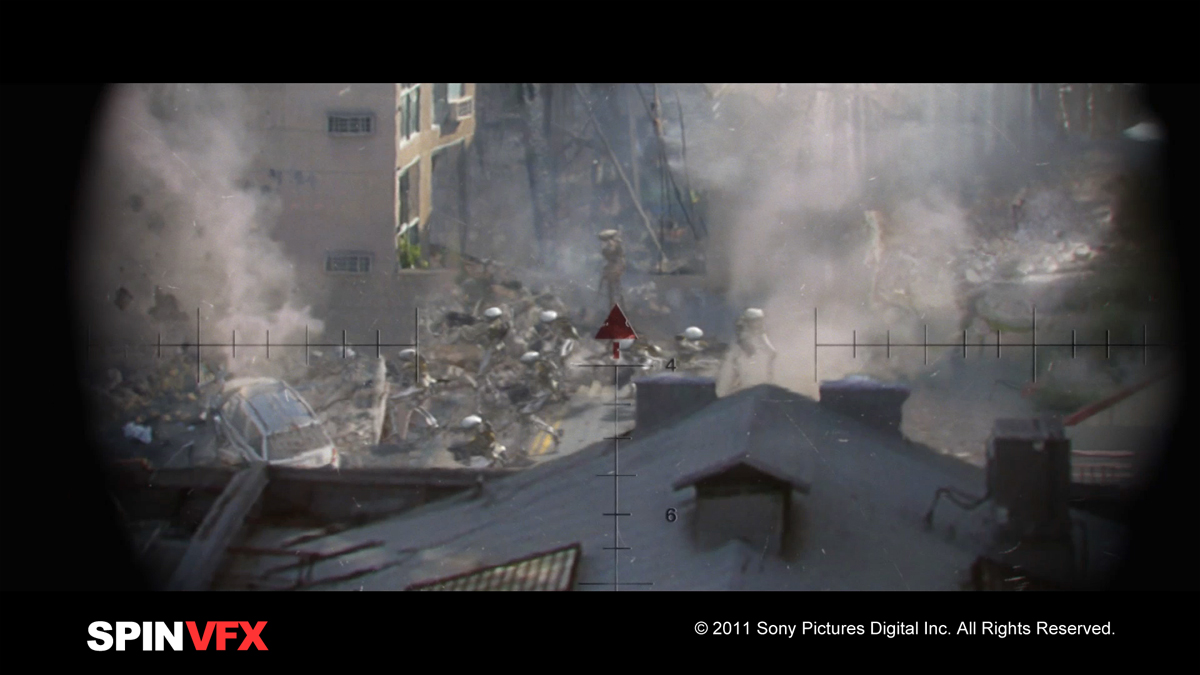 |
Is the style of shooting with the camera constantly moving caused you such troubles especially for tracking?
You said it brother! Tracking was a challenge. We often ended up guessing and manually setting keys by eye. Takes me back to the digital caveman days, before tracking, working on a Quantel Harry. Sometimes the motion blur you add back to the shot helps cover some nasty problem areas!
Can you explain in detail the sequence on the roof of the police?
The Rooftop Police sequence consisted of 35 shots. It was the largest sequence Spin delivered and mostly consisted of bluescreen plates of 2 soldiers getting a wider perspective as to what the Aliens were up to. We built a 280-degree multiplane cyclorama to cover all the angles. The multiplane was used to give a sense of parallax and to help integrate the live action elements like explosions, smoke, trees and ocean.
The set piece was probably 20’x 20’ and was used for the scouting point of the soldiers. The wider shots were real rooftop location plates shot in Baton Rouge. We had to create mattes to replace the environment with our destroyed LA matte painting. It was tough because there were so many wires on the real rooftop that we would either roto or replace with new ones.
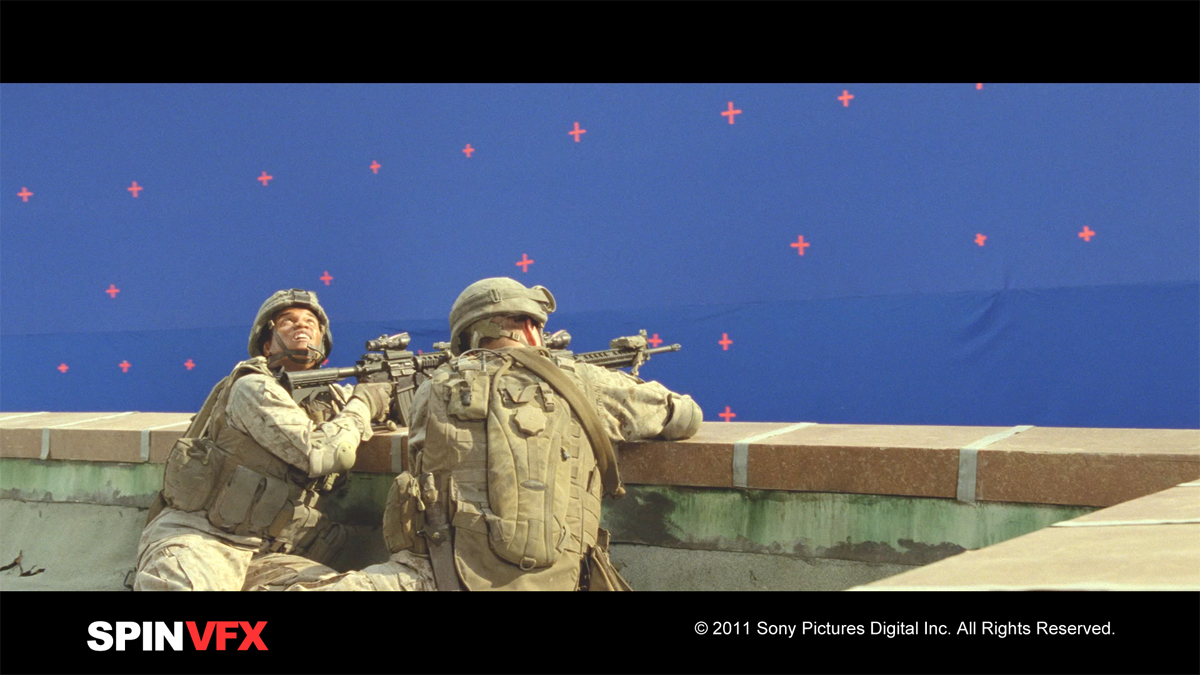 |
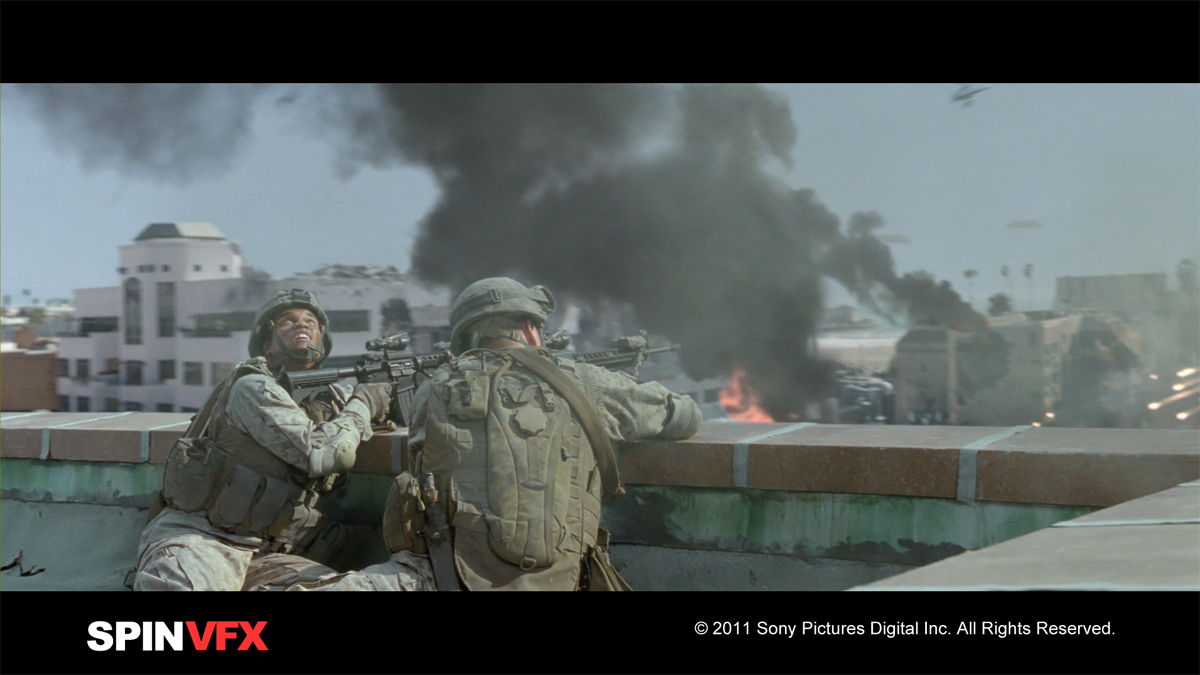 |
Are you involved to help and increase the special makeup?
Yes, those are the alien autopsy shots. We were asked to bring them to life. It was a great opportunity to create the details of how these creatures work. It was an important story point as this is where they discover how to kill them.
We made a cg eye, which was a small tracking device that would scan randomly along a track. The ears, various gears and fan ports were built and tracked on. The mouth was like a vibrating bladder that was animated using a displacement map. The legs were also CG, which moved and twitched. The rest of the body movements came from mesh warps in comp. When Aaron Eckhart was stabbing the heart, the photographed plates were not in line with the directors’ vision. Jonathan wanted to clearly show that these creatures were fueled by seawater so we built a CG semi transparent heart filled with pumping seawater. The lower velocity fluid that interacted with the plate was created in Realflow. The higher velocity fluids, which included the sprays & bursts when the alien was stabbed, were live action elements that Everett shot for us.
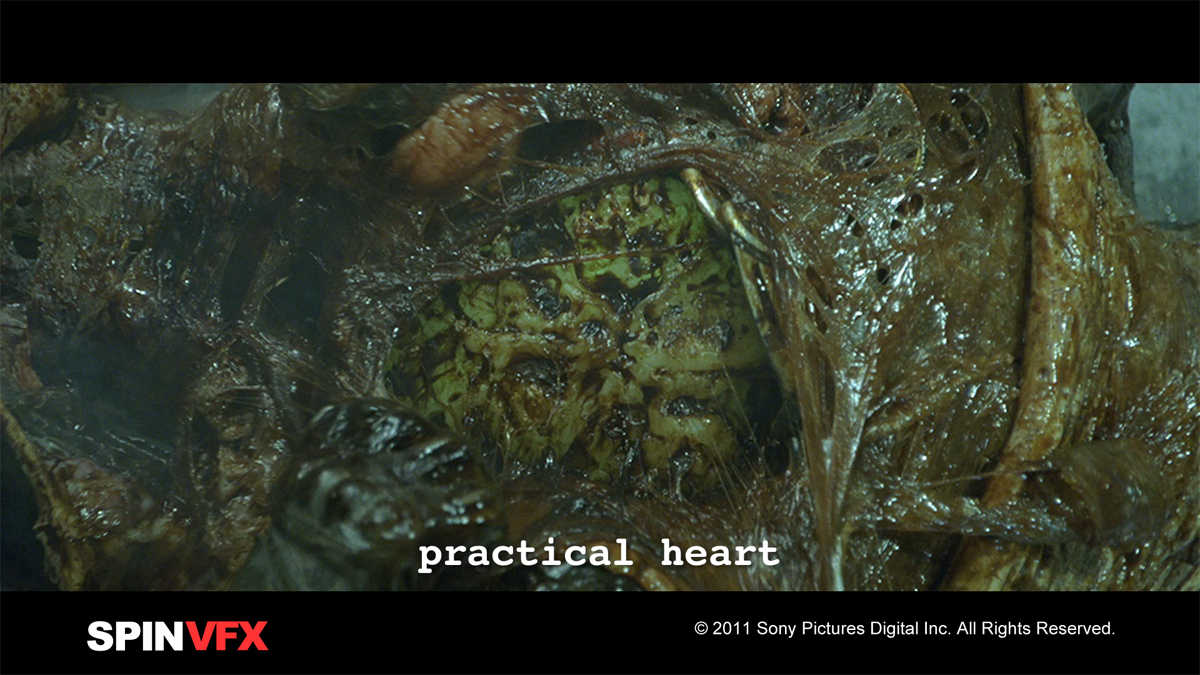 |
 |
How did you create the impressive shot of the Marines alone in the middle of a devastated neighborhood?
Jonathan had blocked this shot out in After Effects to give us a general idea of the look and timing of the shot. The only plate we were given was a green screen plate of the soldiers. We wanted to base the shot on an actual location so production shot an approved still to use as reference for the matte painting. To bring the shot to life, we added live action smoke elements and used Maya nCloth/dynamics to add blowing fabrics, blowing papers, and falling debris. We added a dogfight and flack bursts in the sky to tell the story that the Air force were being successful in hold off the Aliens.
How did you create the shots for the bus on the highway?
We didn’t do these shots for the film, however, I did do this shot in the concept short film that was used to get the show greenlit.
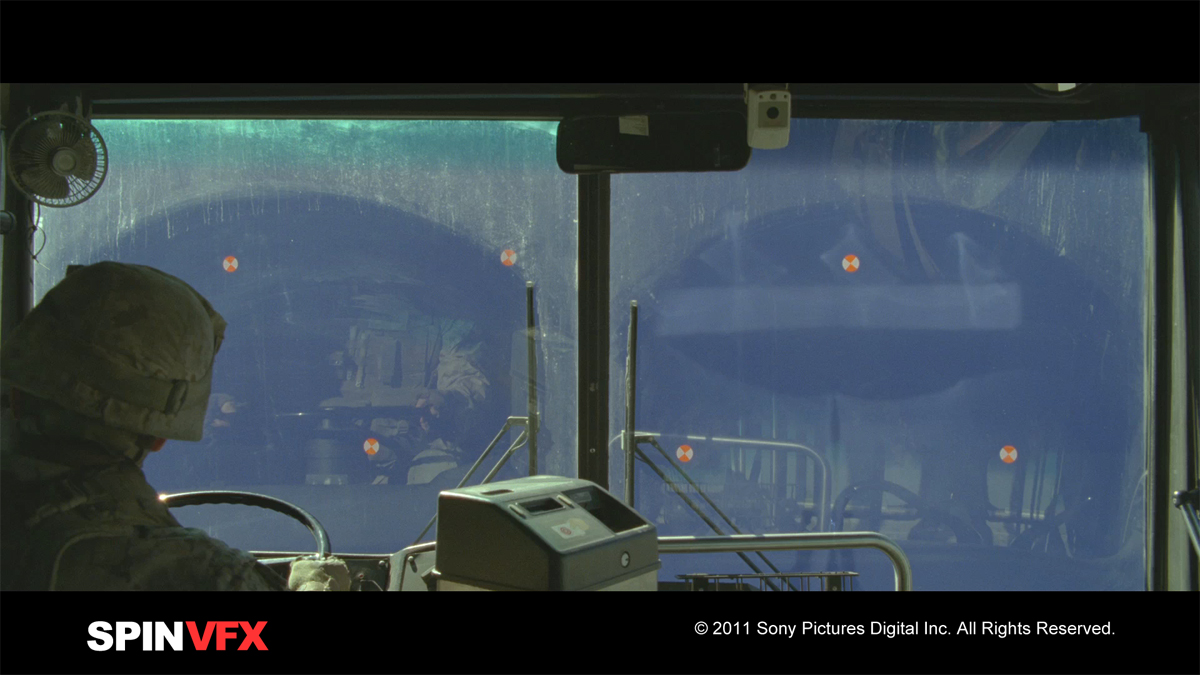 |
 |
What did you do on the shot showing the Marines that goes in helicopters at the end of the film?
We added half a dozen additional Hueys going back into battle. The plate only had one live action helo in it, which wasn’t enough. The director wanted to show a stronger force going back into battle thus the reason why we were also given the final end shot.
 |
 |
Can you explain in detail the creation of the final shot?
That shot had already been completed by another vendor but failed to support the story so a whole new approach was conceived involving a new plate and a grander vision to convey.
The camera pans up over a ridge to a spectacular, wide shot with a dozen helicopters and two F18’s overtaking the camera, heading back into battle against a backdrop of the totally destroyed L.A.
We where supplied an aerial film plate of the Hollywood hills revealing downtown LA. Production supplied the Helicopter asset from another vendor in which we had to develop our own shaders and rigs. We built the F18’s. The matte painting was created in Photoshop and fed into Nuke as a multiplane card projection. A 3d camera was also used in Nuke to add additional live action fire and smoke elements.
What was your feeling of participating in the destruction of a city like Los Angeles? Your artists should love that.
Yeah – destruction work is always fun and makes for GREAT before and afters! The compositors really enjoyed it as well because they got to use really good large-scale explosion elements that Everett shot in Baton Rouge.
 |
 |
What was the biggest challenge on this project?
The biggest challenge was checking in all the assets from different vendors. Because shaders were held back, we had to rebalance and figure out the attribute maps and match established looks. New rigs were developed as the existing ones did not translate well from other software packages or because custom scripts were not provided. We also had 3 major features in house at the same time. With multiple productions including so many assets and sequences, the tool that really stands out to me is our production management software, SPINternal. Developed by Blair Tennessy, Spin’s TD, SPINternal is a python based server, which manages production, file system and user and group information. Its interface is web based. We couldn’t be nearly as efficient without it. It relieves the artist from repetitive tasks, which in turn improves productivity and quality.
How was the collaboration between the different VFX vendors?
Everett kept that process invisible to us. The assets would arrive through production. The Drone ship arrived as an XSI scene, was a bit of an unexpected task having to convert shaders to Maya. The Garage Band (Battle LA’s in-house VFX team) would provide us with their cool Nuke Gizmos.
Was there a shot or a sequence that prevented you from sleeping?
No. Our team is pretty flexible when it comes to even the most difficult challenges and you learn to put out fires before they happen. If you can’t sleep at night you will burn out fast in this business.
How long have you worked on this film?
July 2010 to September 2010.
How many shots have you made and what was the size of your team?
We finished 200 shots using around 50 artists and production staff.
What do you keep from this experience?
My virginity. Ha just joking, I lost it on MAX PAYNE.
What is your next project?
I’m currently involved in another studio development project shooting this summer. The facility is busy finishing Season 1 of THE BORGIAS for Showtime. We are also working on DREAMHOUSE (Morgan Creek) and PRIEST (Screen Gems).
A big thanks for your time.
// WANT TO KNOW MORE ?
– SPIN VFX: Dedicated BATTLE LOS ANGELES page on Spin VFX website.
– fxguide: Complete article about BATTLE LOS ANGELES on fxguide.
// BATTLE LOS ANGELES – SPIN VFX – VFX REEL
© Vincent Frei – The Art of VFX – 2011










Estos aliens son de los más raros y bizarros (sin mencionar tétricos) que vi en el cine 😛
Me encantó el trabajo que realizaron. Saludos de Corrientes Capital, Argentina!